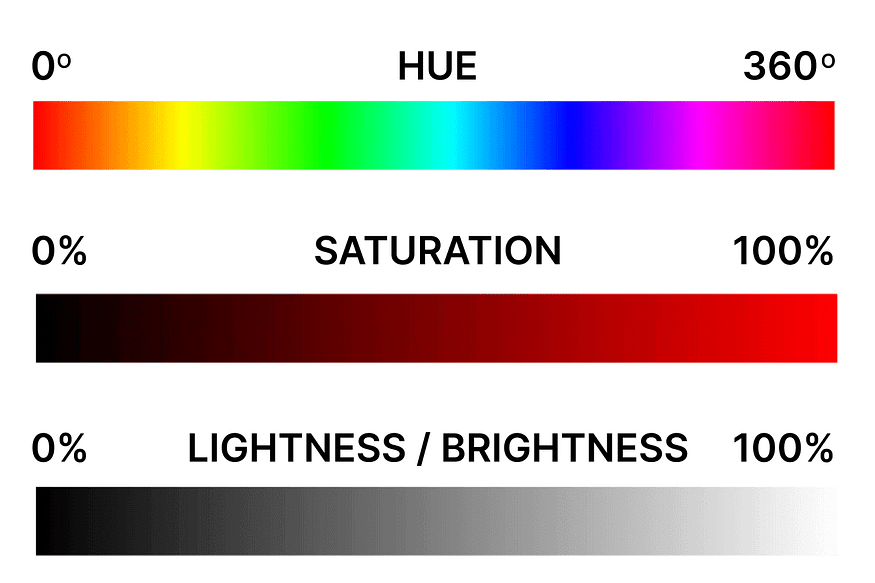HTML HSL and HSLA Colors

HSL stands for hue, saturation, and lightness.
HSLA color values are an extension of HSL with an Alpha channel (opacity).
HSL Color Values
In HTML, a color can be specified using hue, saturation, and lightness (HSL) in the form:
hsl(hue, saturation, lightness)
Hue is a degree on the color wheel from 0 to 360. 0 is red, 120 is green, and 240 is blue.
Saturation is a percentage value. 0% means a shade of gray, and 100% is the full color.
Lightness is also a percentage value. 0% is black, and 100% is white.
Experiment by mixing the HSL values below:

Example:
<!DOCTYPE html>
<html>
<body>
<h1 style="background-color:hsl(0, 100%, 50%);">hsl(0, 100%, 50%)</h1>
<h1 style="background-color:hsl(240, 100%, 50%);">hsl(240, 100%, 50%)</h1>
<h1 style="background-color:hsl(147, 50%, 47%);">hsl(147, 50%, 47%)</h1>
<h1 style="background-color:hsl(300, 76%, 72%);">hsl(300, 76%, 72%)</h1>
<h1 style="background-color:hsl(39, 100%, 50%);">hsl(39, 100%, 50%)</h1>
<h1 style="background-color:hsl(248, 53%, 58%);">hsl(248, 53%, 58%)</h1>
</body>
</html>A new web page opens as shown below:

Saturation
Saturation can be described as the intensity of a color.
100% is pure color, no shades of gray.
50% is 50% gray, but you can still see the color.
0% is completely gray; you can no longer see the color.
<!DOCTYPE html>
<html>
<body>
<h1 style="background-color:hsl(0, 100%, 50%);">hsl(0, 100%, 50%)</h1>
<h1 style="background-color:hsl(0, 80%, 50%);">hsl(0, 80%, 50%)</h1>
<h1 style="background-color:hsl(0, 60%, 50%);">hsl(0, 60%, 50%)</h1>
<h1 style="background-color:hsl(0, 40%, 50%);">hsl(0, 40%, 50%)</h1>
<h1 style="background-color:hsl(0, 20%, 50%);">hsl(0, 20%, 50%)</h1>
<h1 style="background-color:hsl(0, 0%, 50%);">hsl(0, 0%, 50%)</h1>
<p>With HSL colors, less saturation mean less color. 0% is completely gray.</p>
</body>
</html>
A new web page opens as shown below:

Lightness
The lightness of a color can be described as how much light you want to give the color, where 0% means no light (black), 50% means 50% light (neither dark nor light), and 100% means full lightness (white).
Example
<!DOCTYPE html>
<html>
<body>
<h1 style="background-color:hsl(0, 100%, 0%);">hsl(0, 100%, 0%)</h1>
<h1 style="background-color:hsl(0, 100%, 25%);">hsl(0, 100%, 25%)</h1>
<h1 style="background-color:hsl(0, 100%, 50%);">hsl(0, 100%, 50%)</h1>
<h1 style="background-color:hsl(0, 100%, 75%);">hsl(0, 100%, 75%)</h1>
<h1 style="background-color:hsl(0, 100%, 90%);">hsl(0, 100%, 90%)</h1>
<h1 style="background-color:hsl(0, 100%, 100%);">hsl(0, 100%, 100%)</h1>
<p>With HSL colors, 0% lightness means black, and 100 lightness means white.</p>
</body>
</html>A new web page opens as shown below:

HSLA Color Values
HSLA color values are an extension of HSL color values, with an Alpha channel — which specifies the opacity for a color.
An HSLA color value is specified with:
hsla(hue, saturation, lightness, alpha)
The alpha parameter is a number between 0.0 (fully transparent) and 1.0 (not transparent at all):
Experiment by mixing the HSLA values below:
<!DOCTYPE html>
<html>
<body>
<h1 style="background-color:hsla(9, 100%, 64%, 0);">hsla(9, 100%, 64%, 0)</h1>
<h1 style="background-color:hsla(9, 100%, 64%, 0.2);">hsla(9, 100%, 64%, 0.2)</h1>
<h1 style="background-color:hsla(9, 100%, 64%, 0.4);">hsla(9, 100%, 64%, 0.4)</h1>
<h1 style="background-color:hsla(9, 100%, 64%, 0.6);">hsla(9, 100%, 64%, 0.6)</h1>
<h1 style="background-color:hsla(9, 100%, 64%, 0.8);">hsla(9, 100%, 64%, 0.8)</h1>
<h1 style="background-color:hsla(9, 100%, 64%, 1);">hsla(9, 100%, 64%, 1)</h1>
</body>
</html>A new web page opens as shown below:


No comments:
Post a Comment